Accepted Scientific Name: Oreocereus celsianus (Salm-Dyck) A.Berger ex Riccobono
Boll. Reale Orto Bot. Palermo 8: 259. 1909
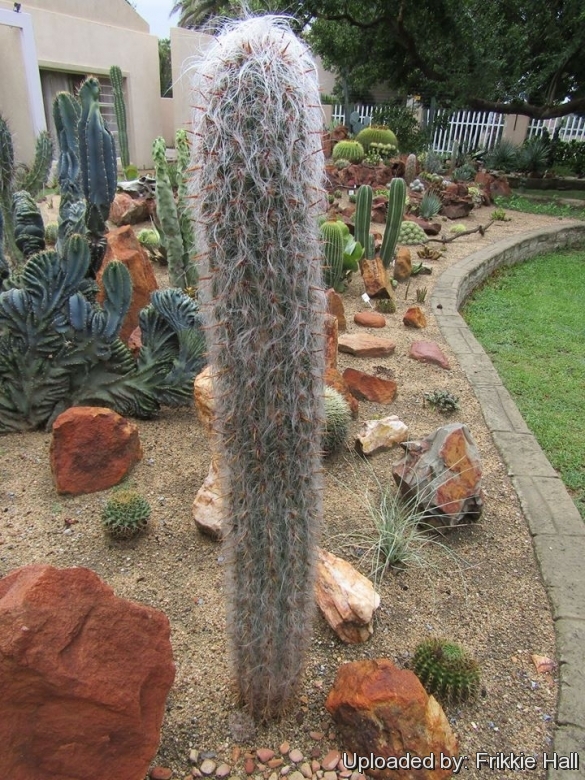
Borzicactus celsianus (Oreocereus celsianus) Photo by: Frikkie Hall
Origin and Habitat: Oreocereus celsianusSN|5952]]SN|5952]] is widely spread at high altitudes in Argentina (prov. Jujuy), Bolivia (dpt. Chuquisaca, Potosí, Tarija) and Peru. The species is common and abundant.
Altitude: (2.600-) 2.900-3.600 (-4.000) metres above sea level.
Habitat: It occurs naturally in semi-arid Andean region in sceltered sites on rocky, well-drained soils among high mountains, mostly in slopes with orientation to the east and north. It is often the only emerging plants between the low Xerophyte Puna-Vegetation. It flourishes in areas characterized by a cold and dry climate in winter and warm with rare rainfalls in summer
Ecology: It is believed that the white hairs provide protection from the intense ultraviolet light of the higher altitudes and is also equipped with "antifreeze chemicals" in its sap that make it somewhat frost resistant. The particularly structured flowers are pollinated by the largest of the hummingbirds (Patagona gigas). There are no major threats to this species.
Synonyms:
See all synonyms of Oreocereus celsianus
back
Accepted name in llifle Database:Oreocereus celsianus (Salm-Dyck) A.Berger ex RiccobonoBoll. Reale Orto Bot. Palermo 8: 259. 1909Synonymy: 26
Cultivars
(1):
back
Common Names include:
ENGLISH: Old Man of the Andes, Old man of the mountain
GERMAN (Deutsch): Alter Mann der Anden
Description: Oreocereus celsianusSN|5952]]SN|5952]], or the "old man of the Andes" is a columnar, cactus growing in clumps that, in the wild, may reach and exceed 3 m of height (but usually less than 2 m tall). It is difficult to see the shape of the ribbed stem, as it is thickly clothed with silky white hairs.
Stem: Thick, erect, cylindrical up 8-12 cm in diameter, covered in a downy white hair, with greatest density at the tips of stems receding to near-bare at the base. The stems branch with time at the base, the new branches are either prostrate or ascending, erect above.
Ribs: 9-25 straight, about 1 centimeter tall, with just prominent rounded tubercles and green-grey to dark green epidermis.
Areoles: Large and white, oval, with white silky hair up to 5 cm long and densely spiny.
Central spines: Robust 1-4, acicular, subulate up to 8 cm long yellowish to reddish brown.
Radial spines: 7-9 up to 2 cm long.
Flowers: Diurnal, tubular or slightly funnel-shaped, slightly curved , pale purplish pink to dark red, 7-9 cm long and 3 cm in diameter. They appear laterally almost at the top of the plant and only after the plant is several years old. Floral tube covered by short scales and long white and black hairs. Outer tepals greenish brown, the inner ones mauve pink to dark red. Filaments red.
Blooming season: Spring
Fruit: Globular, 3-5 cm in diameter dry, yellow that split open at the base with several black seeds.
Subspecies, varieties, forms and cultivars of plants belonging to the Oreocereus celsianus group
 Oreocereus celsianus (Salm-Dyck) A.Berger ex Riccobono: is a columnar cactus growing in clumps up to 3 m tall, stems thickly clothed with silky white hairs and yellowish to reddish brown spines. Distribution: Argentina, Bolivia and Peru.
Oreocereus celsianus (Salm-Dyck) A.Berger ex Riccobono: is a columnar cactus growing in clumps up to 3 m tall, stems thickly clothed with silky white hairs and yellowish to reddish brown spines. Distribution: Argentina, Bolivia and Peru. Oreocereus celsianus cv. Brown-black Hairs: has dense brown, or black hairs (not white).
Oreocereus celsianus cv. Brown-black Hairs: has dense brown, or black hairs (not white).
Bibliography: Major references and further lectures
1) Nathaniel Lord Britton, Joseph Nelson Rose “Cactaceae: Descriptions and Illustrations of Plants of the Cactus Family” Courier Dover Publications, 1963
2) James Cullen, Sabina G. Knees, H. Suzanne Cubey “The European Garden Flora Flowering Plants: A Manual for the Identification of Plants Cultivated in Europe, Both Out-of-Doors and Under Glass” Cambridge University Press, 11/Aug./2011
3) David Hunt, Nigel Taylor “The New Cactus Lexicon” DH Books, 2006
4) Edward F. Anderson “The Cactus Family” Timber Press, 2001
5) Demaio, P., Kiesling, R. & Lowry, M. 2013. Oreocereus celsianus. The IUCN Red List of Threatened Species. Version 2015.1. <www.iucnredlist.org>. Downloaded on 19 June 2015.
6) Wikipedia contributors. "Giant hummingbird." Wikipedia, The Free Encyclopedia. Wikipedia, The Free Encyclopedia, 31 May. 2015. Web. 19 Jun. 2015.
7) Larrea-Alcázar, Daniel M.; López, Ramiro P. (7 July 2011). "Pollination biology of Oreocereus celsianus (Cactaceae), a columnar cactus inhabiting the high subtropical Andes". Plant Systematics and Evolution 295 (1-4): 129–137.
 Borzicactus celsianus (Oreocereus celsianus) Photo by: Frikkie Hall
Borzicactus celsianus (Oreocereus celsianus) Photo by: Frikkie Hall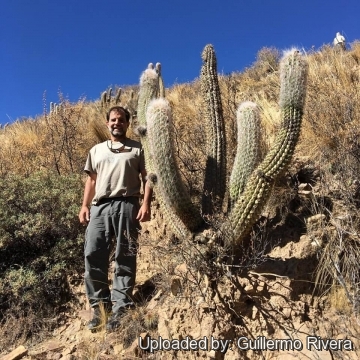 Another nice day with clear skies in Bolivia with Oreocereus celsianus (Oreocereus celsianus) Photo by: Guillermo Rivera
Another nice day with clear skies in Bolivia with Oreocereus celsianus (Oreocereus celsianus) Photo by: Guillermo Rivera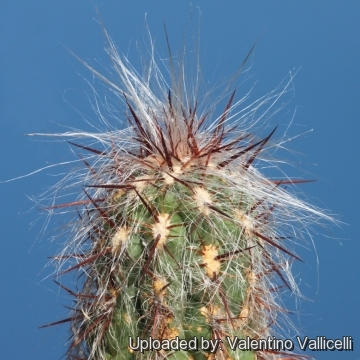 Borzicactus celsianus (Oreocereus celsianus) Photo by: Valentino Vallicelli
Borzicactus celsianus (Oreocereus celsianus) Photo by: Valentino Vallicelli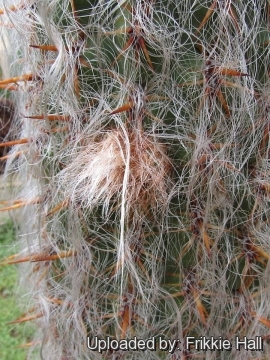 Borzicactus celsianus (Oreocereus celsianus) Photo by: Frikkie Hall
Borzicactus celsianus (Oreocereus celsianus) Photo by: Frikkie Hall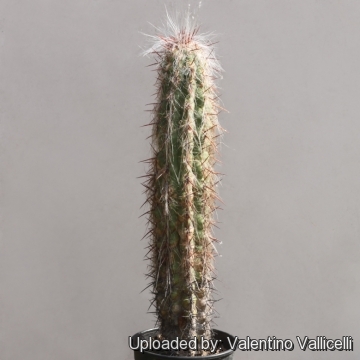 Borzicactus celsianus (Oreocereus celsianus) Photo by: Valentino Vallicelli
Borzicactus celsianus (Oreocereus celsianus) Photo by: Valentino Vallicelli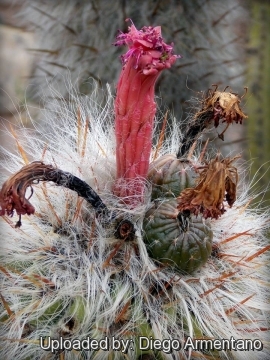 Notocactus scopa, north-west of Argentina (Oreocereus celsianus) Photo by: Diego Armentano
Notocactus scopa, north-west of Argentina (Oreocereus celsianus) Photo by: Diego ArmentanoCultivation and Propagation: This is a a much decorative frost hardy cactus easily found in cultivation.
Soil: Grow it in a rich and particularly draining substratum, as it is very sensitive to rottenness when in presence of humidity and low temperatures and let the soil dry out between waterings.
Water: In summer, during the vegetative period, it must be regularly watered, but allowing the substratum to completely dry up before irrigating again; in winter, it’s to be kept dry. Preferable not to water on overcast days, humid days or cold winter days.
Hardiness: This is the hardiest of the woolly columnar 'old man' cacti from the highland of Bolivia, Peru & northern Argentina that grow at an altitude of up to 4000 meters. It is a very frost resistant cactus, hardy to -7°/-12° C (- 20° C if very dry). However in cultivation it is better not to expose it to temperatures lower than -5° C, even if in an aerated and protected location, in order to avoid the formation of anti-aesthetic spots on the epidermis. In presence of high atmospheric humidity avoid any frost as it is particularly sensitive to root rot.
Exposure: It need full sun exposures with ample airflow to produce dense hairs, but, as a former mountain dweller, does not care for extremely high temperatures in summer.
Maintenance: Repot in the spring, when their roots become cramped. Generally, they should be repotted every other year in order to provide fresh soil. After repotting, do not water for a week or more.
Use: Excellent as landscape or patio plant. It is suitable for small “desert” gardens, in association with other xerophytes. Where the open air cultivation is not possible due to the climate, it is to be cultivated in pot in order to shelter it in winter.
Propagation: By seeds and by cuttings, provided left drying up well, in summer.
















